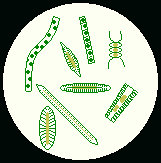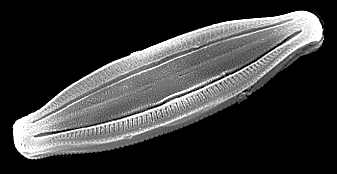Without the plants in a stream or a river, no animals could live. Even though a lot of animals may be carnivores (eat other animals), like stoneflies or trout do, it all starts with plants. Plants grow; an herbivore, like a mayfly, eats them; and a carnivore eats the herbivore. So you see, in a very real way, carnivores must have plants to survive.
In some slower streams and larger rivers, one can often see various kinds of grasses or leafy plants growing underwater. These we call macrophytes ("big plants"). They include pond lilies, duckweed, and hyacinths, among many other types of plants. On them, you'll find fuzzy-looking green stuff. This is algae, strings of single-celled plants. Both the macrophytes and the algae are plants, and both have chlorophyll, a green pigment that allows them to perform a true miracle.
By using chlorophyll, plants can take sunshine, water, and carbon dioxide--which by themselves won't fill us up or help us breathe--and turn it into sugar and oxygen. This is why all animal life on Earth can exist, because plants do this, and we eat and breathe what they've made.
A stream is no different. However, if you have stood and looked into a cold, clear, fast-flowing stream, you'll notice that you can't see any plants. Does this mean that nothing lives there?
Streams flow much too fast to allow macrophytes to live in them. And most algae is washed away quickly. If you look very, very closely, however, you may see long, very thin strands of green waving downstream from their attachment to a rock. These are long strands of an algae called, Cladophora. But most of the plants in the stream won't be visible to you; that is, unless you know what to look for.
 Anyone who has ever tried to walk across a stream knows that the rocks under the water are slippery.
If you were to scrape a bit of that slime off and put it on a glass slide, and look at it under a
microscope, you would see something much like this.
Anyone who has ever tried to walk across a stream knows that the rocks under the water are slippery.
If you were to scrape a bit of that slime off and put it on a glass slide, and look at it under a
microscope, you would see something much like this.
Amid the tiny strings of green algae, a different kind of plant can be seen, one that has only one cell. Instead of the bright green of chlorophyll, these plants, as you can see here, are a brownish-yellow. These plants are called diatoms, and they have a special yellow sunlight-gathering pigment in addition to their green pigment, which is why you don't see green. In fact, it's this brownish-yellow color that you have seen covering the rocks of mountain rivers. And it is what makes the rocks slippery. It so happens that these plants are the favorite food of many of the stream's herbivores!
Diatoms of many different types cover all the wet surfaces of the stream: the rocks, the leaves and sticks and
logs that have fallen in, and various kinds of debris. In fact, the streambed is coated with plants! Diatoms also cause the foam you sometimes see in streams. Each diatom builds itself a little house, and rapids can pound these houses to bits, resulting in foam.
Diatoms grow in rivers, too, of course (and lakes and the ocean as well). In the
rivers, they will coat the macrophytes--those big, green plants--right in among the fuzzy green algae.
In fact, even where you see macrophytes, it will be these microscopic diatoms and algae coating them
that do most of the work of providing food and oxygen to the stream's inhabitants.
Diatoms, which are often yellow-green, and algae, which are green or blue-green, are both one-celled organisms. (Though are often strung together in colonies). We call both diatoms and algae phytoplankton ("drifting plants"). One-celled animals, on the other hand, are called zooplankton ("drifting animals").
Often the greatest contributor of plant food to streams is the riparian zone: the margins
along the stream that are filled with vegetation. These plants, like all plants, drop their leaves--which
fall into or are washed into the stream. This is allochthonous matter (from outside the stream), as
opposed to autochthonous matter (from inside the stream, like algae and diatoms). These leaves can't
make oxygen, since they are dead, but they provide food to the creatures in the stream. Not only the leaves
themselves can be eaten, but also whatever bacteria or fungus is covering the leaves, rotting them. It is this
bacteria and fungus that is what crayfish are really after when they eat decaying plant matter. Riparian plants also have bugs on them which drop into the stream and provide food to stream-dwellers.
Riparian areas are valuable for more than just food. Riparian plants--like willow, alder, cottonwood, birch, cedar, alligator juniper, locust, and many others--help stabilize banks with their roots, provide shade from the sun (which gives the stream more complex habitats and helps keep it cool), assist in providing the correct stream acidity, absorb toxins, provide large woody debris (LWD) in which stream-dwellers can live, absorb floodwaters, assist in recharging aquifers, and help retain sediment (which keeps streams clean).

![]() To learn more about habitats, check out the reading list, where you will find some excellent references listed. (You will be able to order them from here, too).
To learn more about habitats, check out the reading list, where you will find some excellent references listed. (You will be able to order them from here, too).
 More macrophyte and algae links, including photos and keys.
More macrophyte and algae links, including photos and keys. Plankton key or (or try here).
Plankton key or (or try here).

| Site Search |
These houses are made like little boxes, with a bottom half and a lid that fits
over it, just like a jewelry box. The two halves are called, frustules.
Since different diatoms make different frustules, identification is often made
on the basis of what the frustule looks like.
Identification of diatoms by looking at frustules isn't easy, because there are so many thousands of kinds of diatoms in the world. Another thing that makes it difficult is that it is so hard to see the frustule clearly. Under a microscope, the opaline boxes refract light back to the viewer, making them very pretty indeed--but also making it difficult to see details. For this, one must use a scanning electron microscope, which bombards the diatom with electrons. It will show even the finest details--but it unfortunately removes the truly beautiful refractions that you might see in an ordinary photograph. As you can see, though, their architecture has a beauty of its own:



|
(These images are courtesy of Bowling Green State University's Center for Algal Microscopy).